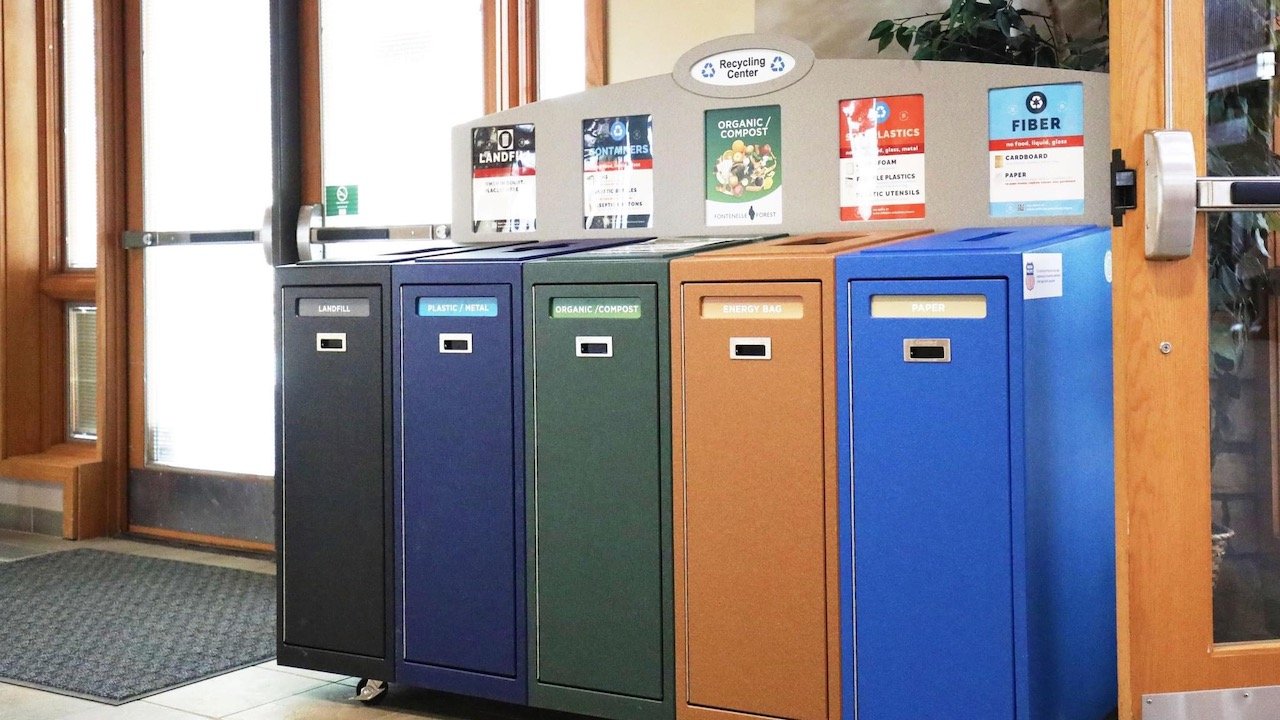How to Create Impactful & On-Brand Signage
Sometimes, when someone pushes for a zero-waste program, they hit a wall with their marketing team. They’re a clan hesitant to roll out a new program, not because it doesn't work wonders, but because it just doesn't vibe with the company aesthetic.
The look of a brand and its space really speaks volumes. That's why you'll see arenas splurging millions on making every corner, even the trash bins, scream their brand. And it's the same reason why, when we talk about making a place more eco-friendly, we've got to think about how it all fits together visually.
But here's the thing—we shouldn't have to compromise our planet for a good brand look. Until designers automatically factor in eco-friendly elements into a brand's identity, we’ll craft custom signage to fit a brand to a T and champion sustainability efforts.
Hold up, wait a minute! Why does signage matter?
Ever found yourself staring at recycling bins, trying to figure out where to toss your items? You're not alone. Without clear signs, what should be a simple act of sustainability turns into a mini puzzle.
People want to do the right thing. They don’t always know how to.
This moment of hesitation leads to what we call "wish cycling" - a hopeful toss into the recycling bin, praying it belongs there, even when we're not quite sure. This well-intentioned but misguided action contaminates the recycling stream, making the process more difficult and expensive.
The problem: Most cans read “recycling” and it’s not useful. What is recycling? Ask most Americans and they’ll have no idea. In fact, successful programs assume no one knows what to do and then create safety nets along the way.
Us: You need signage.
Marketing: We need pretty signage.
Navigating the sweet spot between making signs look good and ensuring they're crystal clear, especially when your brand's vibe is on the line, can be a bit of a tightrope walk. Our ready-to-go signs are all about being clear and sticking to those national standards, but we totally get that they've got to gel with your brand's style too.
Loop in your marketing team's graphic designer with these pointers:
#1: Use National Standard Colors
We get it, the urge to tweak those sign & bin colors to perfectly match your color brand kit is strong. But know that inconsistency can create confusion, decrease participation, and increase contamination.
Consider the humble stop light. It's a universal language of red, yellow, and green. Everyone gets it, no matter where you are. That's the magic we need for our zero-waste bin setups. Sticking to those national standards isn't just about rules; it's about making recycling and waste management a no-brainer for everyone.
Color Standards:
Recycling: Blue
Compost: Green
Glass: Orange
Landfill: Black
Energybag: Orange
Insider Tip: Orange is the official color used for glass recycling and Energy Renew Bag, but since orange containers are hard to find, we recommend using blue for anything recycling-related.
#2 Prevent Language Barriers
Clear communication is key in implementing an efficient zero waste program.
If most of your office buddies chat in English, it's totally cool to stick with English-only signs. But it’s notable to recognize the diversity within your workplace.
Example: If there's a chance that Spanish-speaking individuals are part of your team, it’s crucial to accommodate their needs as well. Including bilingual signs in both English and Spanish ensures that everyone is on the same page, literally and figuratively.
Sustainability is a collective effort that thrives on clear and inclusive communication. Thus, by making the program more inclusive, its effectiveness will be enhanced, leading to increased participation and reduced contamination from misunderstandings.
#3 Use Company Single-Waste Specific Photos
First, understand how powerful visuals can be…
Imagine a kiddo who can't read wants to recycle his pop bottle. He doesn't know how to read. What can we do? A photo of a bottle will instantly communicate where the item should go, far more effective than words alone. Adding visuals will harness the universal language of imagery to guide behavior seamlessly and efficiently.
Second, recognize the value of including photos of items often discarded at work...
Our signs simplify sorting what goes where. But dialing down signage with commonly tossed items at YOUR work place will take the cake.
For instance, our sign reads "plastic containers" while the familiar sign at Baxter Subaru states "Empty Oil Cans & Hard Plastics" Their staff will have no doubts about it, especially with the bottle's picture displayed right on the sign.
#4 Add what does NOT belong
Uh-oh! Mistakes can cause the entire batch to become contaminated. This trashes our recycling efforts and leads to a significant portion of recyclables needing to be deemed usable. Often, they end up in the landfill instead of being processed and reused, proving we're in a messy situation. This highlights the refuse-al to fail by stressing the importance of clear, visible instructions for the success of recycling programs.
Add a bright red banner that screams "ABSOLUTELY DO NOT" serves as a safety net. For example, our container recycling sign says "no food, liquid or glass." For instance, consider our container recycling initiative. The signage explicitly states "no food, liquid, or glass" to prevent contamination.
#5 Instruct the proper way to deposit material
Cans with Dr. Pepper still sloshing inside shouldn't be placed in the recycling bin. It's best to ensure cans are empty and dry. Signage should clearly instruct on how to deposit materials into the cart.
Chatting it out with your graphic designer is key to nailing that perfect blend of eye-candy visuals and no-miss messages, helping cut down the confusion and getting everyone psyched about recycling the right way.
In this journey, sharing the ups and downs, how we’re all in this together, makes everything more relatable. The road to a launching a successful recycling program is paved with intention, inclusivity, and clarity.
By adhering to these guidelines we can craft an environment that not only encourages but also simplifies recycling for everyone involved. It's through these meticulously planned steps that we can collectively make a significant impact.






